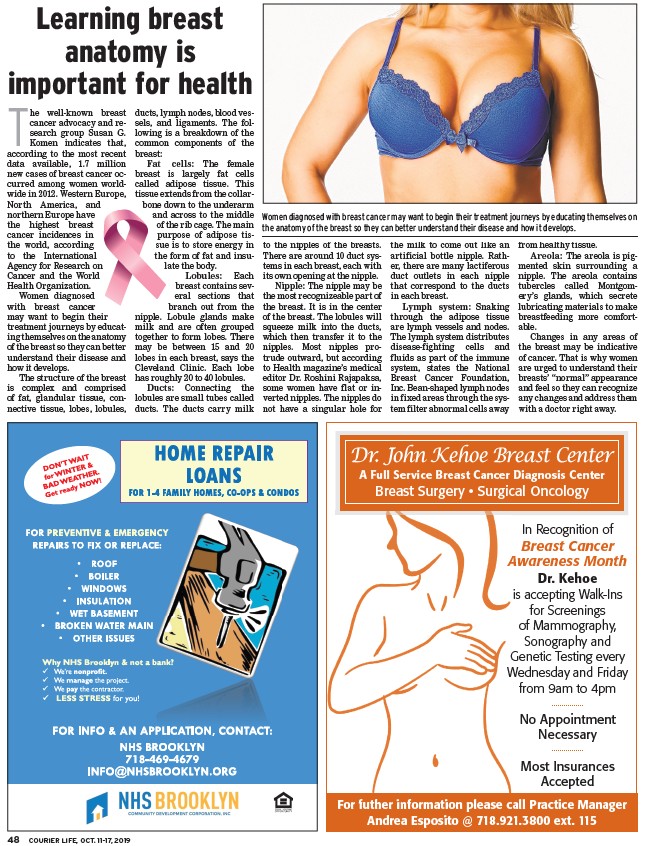
The well-known breast
cancer advocacy and research
group Susan G.
Komen indicates that,
according to the most recent
data available, 1.7 million
new cases of breast cancer occurred
among women worldwide
in 2012. Western Europe,
North America, and
northern Europe have
the highest breast
cancer incidences in
the world, according
to the International
Agency for Research on
Cancer and the World
Health Organization.
Women diagnosed
with breast cancer
may want to begin their
treatment journeys by educating
themselves on the anatomy
of the breast so they can better
understand their disease and
how it develops.
The structure of the breast
is complex and comprised
of fat, glandular tissue, connective
tissue, lobes, lobules,
COURIER L 48 IFE, OCT. 11-17, 2019
ducts, lymph nodes, blood vessels,
and ligaments. The following
is a breakdown of the
common components of the
breast:
Fat cells: The female
breast is largely fat cells
called adipose tissue. This
tissue extends from the collarbone
down to the underarm
and across to the middle
of the rib cage. The main
purpose of adipose tissue
is to store energy in
the form of fat and insulate
the body.
Lobules: Each
breast contains several
sections that
branch out from the
nipple. Lobule glands make
milk and are often grouped
together to form lobes. There
may be between 15 and 20
lobes in each breast, says the
Cleveland Clinic. Each lobe
has roughly 20 to 40 lobules.
Ducts: Connecting the
lobules are small tubes called
ducts. The ducts carry milk
Women diagnosed with breast cancer may want to begin their treatment journeys by educating themselves on
the anatomy of the breast so they can better understand their disease and how it develops.
to the nipples of the breasts.
There are around 10 duct systems
in each breast, each with
its own opening at the nipple.
Nipple: The nipple may be
the most recognizeable part of
the breast. It is in the center
of the breast. The lobules will
squeeze milk into the ducts,
which then transfer it to the
nipples. Most nipples protrude
outward, but according
to Health magazine’s medical
editor Dr. Roshini Rajapaksa,
some women have flat or inverted
nipples. The nipples do
not have a singular hole for
the milk to come out like an
artificial bottle nipple. Rather,
there are many lactiferous
duct outlets in each nipple
that correspond to the ducts
in each breast.
Lymph system: Snaking
through the adipose tissue
are lymph vessels and nodes.
The lymph system distributes
disease-fighting cells and
fluids as part of the immune
system, states the National
Breast Cancer Foundation,
Inc. Bean-shaped lymph nodes
in fixed areas through the system
filter abnormal cells away
from healthy tissue.
Areola: The areola is pigmented
skin surrounding a
nipple. The areola contains
tubercles called Montgomery’s
glands, which secrete
lubricating materials to make
breastfeeding more comfortable.
Changes in any areas of
the breast may be indicative
of cancer. That is why women
are urged to understand their
breasts’ “normal” appearance
and feel so they can recognize
any changes and address them
with a doctor right away.
Learning breast
anatomy is
important for health
Dr. John Kehoe Breast Center
A Full Service Breast Cancer Diagnosis Center
��������������������������������������������������������������������
In Recognition of
Breast Cancer
Awareness Month
Dr. Kehoe
is accepting Walk-Ins
for Screenings
of Mammography,
Sonography and
Genetic Testing every
Wednesday and Friday
from 9am to 4pm
No Appointment
Necessary
Most Insurances
Accepted
For futher information please call Practice Manager
Andrea Esposito @ 718.921.3800 ext. 115